What is a backdoor cut in basketball
A backdoor cut consists of offensive action that occurs when a player without possession of the basketball seeks to get open, typically by way of an initial quick step towards a player with the ball, followed by an immediate cut to the basket.
Afterwards, the player that executed the backdoor cut could possibly receive the ball and score near the basket. It should also be mentioned that the backdoor cut is usually one of the primary basketball cuts utilized in a wide variety of basketball offense strategies, most notably, the Princeton offense.
What are examples of basic backdoor cuts
Basic Backdoor Cut #1
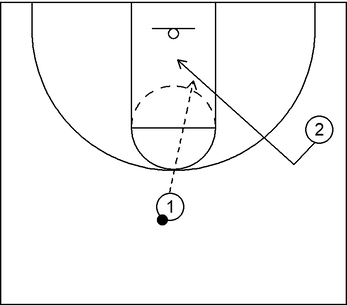
This is a diagram example of a basic backdoor cut that features two offensive players, denoted simply as 1 and 2.
Also, 1 has possession of the basketball at the top of the half court above the three-point line while 2 is initially located near the right side wing area.
To start, 2 simply takes a quick step towards 1 and immediately cuts to the basket.
Following the backdoor cut action, 2 receives the ball from 1 and can finish at the rim with a layup or dunk.
Basic Backdoor Cut #2
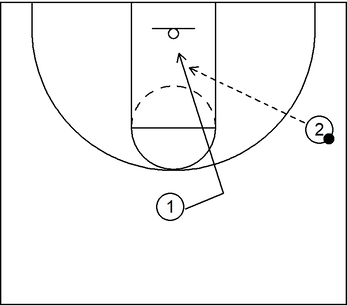
This is another diagram example of a basic backdoor cut that features two offensive players, denoted as 1 and 2.
This time, 2 initially starts with possession of the basketball near the right side wing area. Next, 1 takes a quick step towards 2 and then immediately cuts to the basket.
After the backdoor cut action, 1 receives the ball from 2 and can finish with a layup or dunk.
Basic Backdoor Cut #3
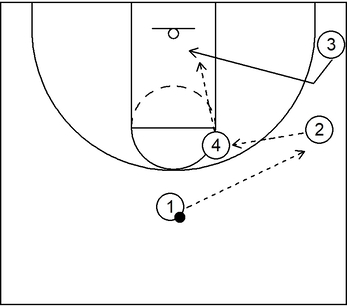
This is yet another diagram example of a basic backdoor cut. However, this sequence features four offensive players, denoted simply as 1, 2, 3, and 4.
To start, 2 receives the ball from 1 and immediately passes it to 4, who is located near the right side high post area.
Following that, 3, who is initially located within the right side corner area, takes a quick step towards 4 (however, 3 could step towards 2 as an alternate option) and immediately cuts to the basket.
After the backdoor cut action, 3 could receive the ball from 4 and score at the rim via a layup or dunk.
Why is the backdoor cut effective in basketball
The backdoor cut is an effective action in basketball because it can mitigate the usefulness of off-ball denial defense near the perimeter and at the same time, it can create a potential scoring opportunity near the basket.
In other words, if an off-ball defender near the top, the wing, or the corner attempts to deny the offensive player that they are guarding from receiving the ball (usually by putting a hand in the passing lane), then the offensive player can counter that defensive tactic with a backdoor cut to the basket.
When that occurs, that same offensive player could receive the ball, typically by way of a bounce pass, and score with a layup or dunk.
The following basketball diagram below attempts to illustrate this point.
Backdoor cut as a counter to denial defense
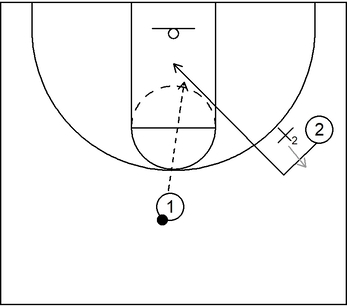
On the diagram, a defender simply denoted as X2 attempts to deny 2 from receiving a potential wing entry pass from 1. This is displayed with a gray arrow for demonstrative purposes.
However, when that occurs, 2 can counter that denial action with a backdoor cut to the basket.
If that backdoor cut is successful, then 2 would be able to create separation from X2 and get open to receive the ball from 1.
What is a general defensive technique to potentially diminish the effectiveness of the backdoor cut
The defender could try to diminish the effectiveness of the backdoor cut, particularly by mirroring the path of the offensive cutter on that player’s inside shoulder.
The following basketball diagram attempts to illustrate this point.
Defender mirrors the path of the backdoor cut
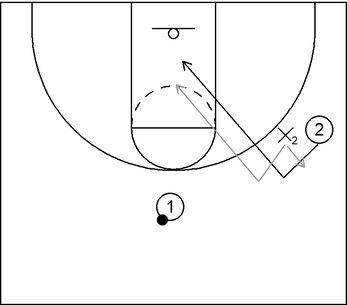
On the diagram, X2 initially executes denial defense against 2, represented by the small gray arrow pointing in the downwards direction.
When that happens, 2 executes a backdoor cut towards the basket as a counter to the denial defense, mainly to get open and cause X2 to trail behind the cutting action.
However, X2 could attempt to limit or prevent the offensive advantage, primarily by turning their body and moving towards the basket on an adjacent path to the backdoor cutter.
This is also represented for demonstrative purposes by a longer gray arrow that points toward the general direction of the basket.
Additionally, in this instance, X2 should generally extend out their left arm to limit or prevent a potential pass from 1.
Moreover, X2 should generally use their right forearm to make contact with the inside shoulder of 2 during the offensive cutting action.
The right forearm helps X2 to feel where 2 is currently located during the cutting action while keeping an eye on the ball, which would be in possession of 1.
Nevertheless, it is important to note that X2 should not extend the right forearm beyond their own space, which is commonly referred to as an imaginary cylinder, as that could lead to illegal contact and a subsequent defensive foul being assessed to X2.
In essence, when the initial static denial defensive action fails due to the offensive backdoor cut counter, X2 could still possibly mitigate it by denying the pass dynamically on the move.
It should also be noted though that this particular counter-to-a-counter tactic would be most effective when the defender such as X2 possesses an adequate amount of speed and quickness, specifically as it relates to footwork, as well as active hands.
Related: Fundamentals Of The Backdoor Cut – YouTube
Related: Fundamentals Of Denying The Pass – YouTube
What are examples of simple scoring plays that use the backdoor cut
These are examples of simple basketball scoring plays that make use of the backdoor cut action.
It should be mentioned as well that the numbers on the diagrams are represented by the standard basketball positions.
That is to say, the number 1 represents the point guard position while the number 2 indicates the shooting guard position.
Furthermore, the number 3 is representative of the small forward position, the number 4 is representative of the power forward position, and the number 5 signifies the center position.
Play 1 – Part 1
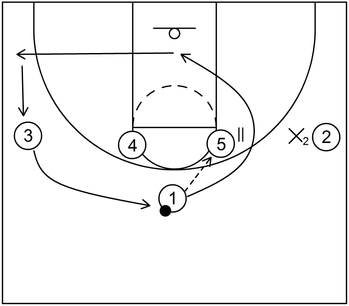
This is an example of a scoring play initiated from a 1-4 high set that uses the backdoor cut. To start, 5 receives the ball from 1 and afterwards, 1 cuts to the basket while 3 fills the vacated spot at the top.
If open, 1 could receive the high post handoff from 5 and quickly score at the rim. Otherwise, 1 cuts through to the left side corner and then to the left side wing.
Additionally, while that occurs, X2 utilizes a hard denial to prevent 2 from receiving the ball.
Play 1 – Part 2
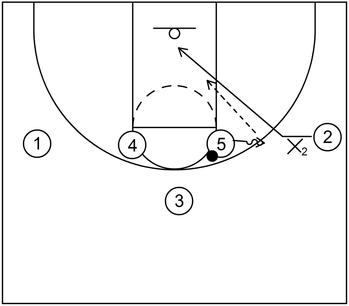
Following the initial action, 5 would like to execute dribble handoff action with 2 but X2 continues to deny as mentioned previously.
Therefore, to counter that defensive tactic, 2 executes a backdoor cut to the basket. From there, 2 quickly receives the ball from 5 and scores at the rim.
Play 2 – Part 1
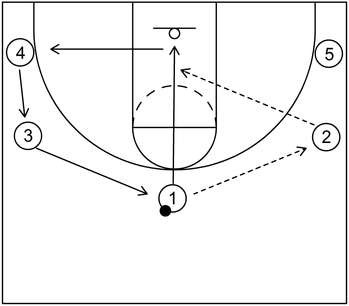
This is an example of a scoring play initiated from the 5 out motion offense that uses the backdoor cut. To begin, 2 receives the ball from 1. After that, 1 cuts to the basket while 3 fills the top and 4 fills the left side wing.
If open, 1 could receive the ball from 2 and score at the rim. Otherwise, 1 fills the left side corner.
Play 2 – Part 2
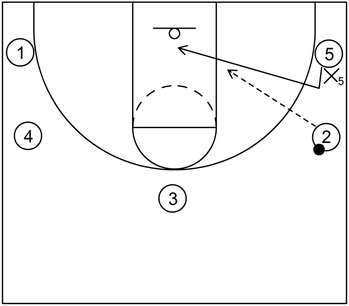
Next, 2 would prefer to pass to 5 in the right side corner. However, 5 is being heavily guarded with denial defense by X5 and cannot easily receive the ball from 2.
Therefore, to counter and release that pressure, 5 backdoor cuts to the basket. Afterwards, 5 receives the ball from 2 and scores at the rim.
Play 3 – Part 1
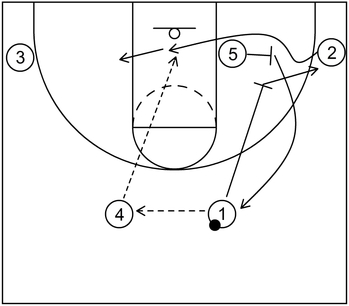
This is an example of a scoring play initiated from the Flex offense that utilizes the backdoor cut. To start, 4 receives the ball from 1 and afterwards, 2 cuts to the basket via the flex screen set by 5.
From that point, 2 could receive the ball and score at the rim if that is open. If 2 is not open, then 2 cuts across the lane to fill the left side low post block.
Also, as that action occurs, 5 cuts to the vacated right side slot via the down screen set by 1. Additionally, 1 fills the vacated right side corner.
Play 3 – Part 2
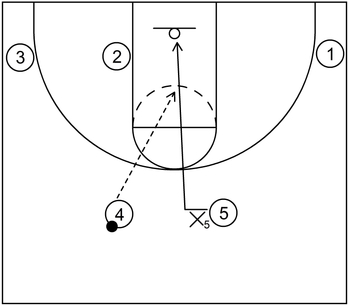
Next, 5 would like to receive the ball from 4 so that the continuity pattern of the Flex offense could get executed. However, X5 does not allow 5 to easily receive the ball by implementing denial defense.
When that occurs, 5 executes a backdoor cut to the basket. Following that, 5 receives the ball from 4 and scores at the rim with a layup or dunk.
Play 4
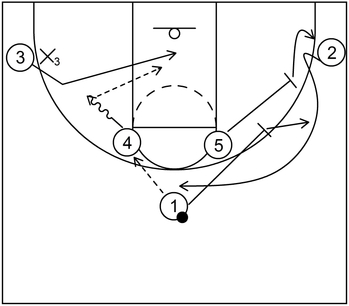
This is an example of a scoring play initiated from the Horns offense that uses the backdoor cut. To begin, 4 receives the ball from 1. After that, 2 cuts to the top via stagger screens set by 1 and 5.
Also, 1 fills the right side wing while 5 fills the right side corner. This action primarily occurs to occupy the defense.
On the ball side, 4 would like to execute a dribble handoff with 3. However, X3 denies 3 from easily receiving the ball.
Therefore, 3 backdoor cuts to the basket and quickly receives the ball from 4. From that point, 3 scores at the rim with a layup or dunk.
Play 5
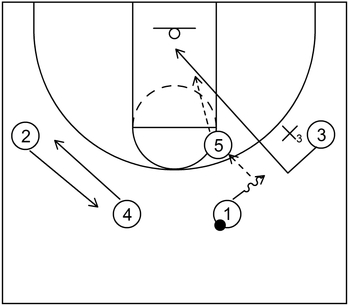
This is an example of a scoring play initiated from the Chin series of the Princeton offense that implements a backdoor cut. To start, 1 dribbles toward 3 to execute a dribble handoff while 2 and 4 interchange spots on the opposite side of the floor.
Unfortunately, X3 does not allow 3 to easily receive the ball by executing denial defense. When that occurs, 5 receives the ball from 1 and then 3 backdoor cuts to the rim.
From there, 3 could receive the ball from 5 and score at the basket with a layup or dunk.
Play 6 – Part 1
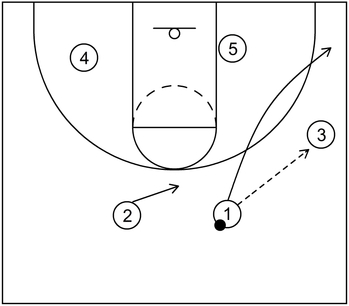
This is an example of a scoring play initiated from the high post series within the Triangle offense that uses a backdoor cut.
To begin, 3 receives the ball from 1 and then 1 cuts through to the right side corner to form the sideline triangle. Also, 2 fills the top from the left slot.
Play 6 – Part 2
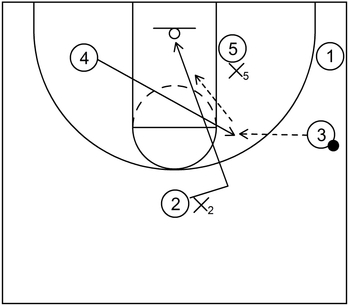
Following that, 3 would prefer to pass inside to the post player but unfortunately, 5 did not shape up properly on the line of deployment (a concept within the triangle offense) to easily receive the ball from 3. This allows X5 to front the post on the high side.
Therefore, 2 is the next available option. However, X2 will not allow 2 to receive the ball by executing the denial defense. When this occurs, 4 flashes across to the right side high post elbow area.
Next, 4 receives the ball from 3 and immediately after that, 2 executes a backdoor cut to the basket, receives the ball from 4, and scores at the rim.
Affiliate Disclosure: I may earn a commission on qualifying purchases made through the links below.
What are examples of simple backdoor cut basketball drills
These are examples of simple basketball breakdown drills that can help players execute backdoor cuts for potential scoring opportunities, particularly near the basket.
It should also be noted that in reference to these particular drills, the numbers for players are used primarily for demonstration purposes and are not necessarily representative of standard basketball positions.
In other words, player 1 does not necessarily have to be a point guard, player 2 does not necessarily have to be a shooting guard, and so forth.
Drill 1
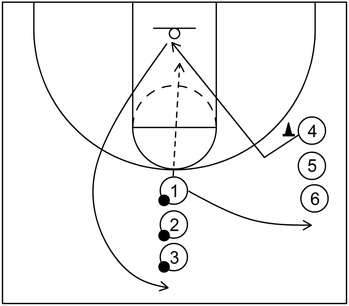
This is an example of a basketball breakdown drill with backdoor cut action. Also, for this example as well as the one that immediately follows it, there are two lines at the top and near the wing.
Players in one of the lines will cut to the basket while players in the other line will pass to the cutting players.
Also, after a cutting player receives the ball and scores at the rim, that same player will then gather the ball after it passes through the basket ring. Following that, that same player will then cut to the passing line.
Likewise, the players that executed a pass will move to the cutting line. Furthermore, a cone is used within the drills to simulate a defender.
However, it is also possible to use a chair or even additional live defenders to deny a player from receiving the ball.
To start this drill, 4 backdoor cuts to the basket from the wing and receives the ball from 1 at the top.
Afterwards, 4 scores at the rim, grabs the ball as it passes through the basket ring, and then cuts to the back of the passing line. At the same time, 1 moves to the back of the cutting line as well.
Drill 2
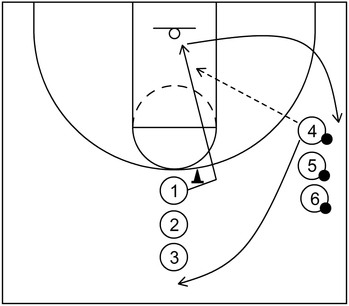
This is another example of a backdoor cut drill that is somewhat similar to the previous one. To start, 1 backdoor cuts to the basket and receives the ball from 4.
After that, 1 scores at the rim, grabs the ball as it passes through the basket ring, and then cuts to the back of the passing line near the right side wing. At the same time, 4 moves to the back of the cutting line at the top.
Drill 3
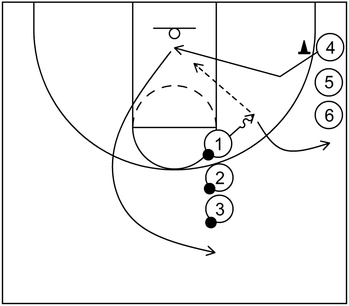
This is yet another basketball drill that could potentially help players create scoring opportunities via the backdoor cut. To begin, 1 dribbles the ball toward 4 as if to execute dribble handoff action.
Following that, 4 backdoor cuts to the basket and scores at the rim. From there, 4 grabs the ball after it passes through the basket ring and then cuts to the back of the passing line. At the same time, 1 moves to the back of the cutting line.
Drill 4
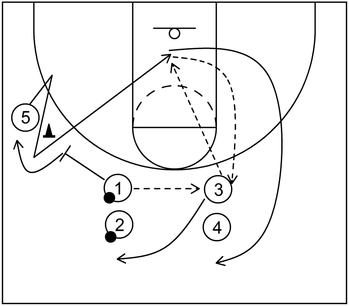
This is an example of a simple basketball drill that features a backdoor cut alongside pass and screen away action.
It is derived from insights within Spread Motion: 4-Out, 1-In Offense by Jamie Dixon.
Essentially, this drill helps the cutting screen receiver practice an offensive counter via the backdoor cut if the defender attempts to jam the screen during an actual game.
In other words, during the execution of basketball offense within a game setting, if the defender attempts to get in between a screen, particularly a screen that is set near the wing area away from the ball, so that an offensive player cannot effectively use that screen, then that same offensive player could counter with a backdoor cut.
Also, for demonstrative purposes, a cone is utilized to simulate a defender. To set up the drill, one or more players should be in the left slot and have possession of at least one basketball.
One or more players should be in the right slot as well while one or more players should be near the left side wing, in this instance.
The players in the left slot will execute the first pass and then screen away from the ball. The players in the right slot will receive the ball during the first pass and then execute the second pass near the basket.
The players near the left side wing will reject the screen, execute a backdoor cut, receive the ball, and score near the rim with a layup or dunk.
To begin this particular example, 3 receives the ball from 1 and following that, 1 cuts away to set a screen for 5.
As that occurs, 5 begins to set up the defender by cutting towards the baseline. Immediately after, 5 moves toward the screen with the initial intent to cut over the top of it.
However, as mentioned previously, the defender, which is the cone for this example, attempts to jam the screen, reducing its effectiveness.
Therefore, 5 counters by rejecting the screen followed by a backdoor cut to the basket. From that point, 5 could receive the ball from 3 and score at the rim with a layup or dunk.
At the completion of the drill, 1 should move to the line near the left side wing. Also, 5 should grab the ball as it goes through the basket ring and then pass it to 3 near the right slot.
From there, 3 should move to the line near the left slot while 5 moves to the line near the right slot. Afterwards, the drill could start again with 4 receiving the first pass from 2 and so on.